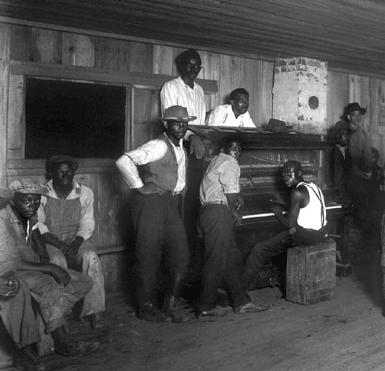
02 - Barrelhouse Pianist
by John Tennison — History of Boogie Woogie

The photo above was taken in Minglewood, TN in 1920. This photo is contained in the Special Collections Photograph Archives of the University of Louisville.
“Boogie Woogie piano playing originated in the lumber and turpentine camps of Texas and in the sporting houses of that state. A fast, rolling bass — giving the piece an undercurrent of tremendous power — power piano playing.”
“Neither Pine Top Smith, Meade Lux Lewis nor Albert Ammons originated that style of playing — they are merely exponents of it.”
“In Houston, Dallas, and Galveston — all Negro piano players played that way. This style was often referred to as a ‘fast western’ or ‘fast blues’ as differentiated from the ‘slow blues’ of New Orleans and St. Louis. At these gatherings the ragtime and blues boys could easily tell from what section of the country a man came, even going so far as to name the town, by his interpretation of a piece.” 1
— E. Simms Campbell, 1939, pages 112-113, (in Chapter 4 "Blues") in the book, "Jazzmen: The Story of Hot Jazz Told in the Lives of the Men Who Created It" 1
Consistent with the findings of E. Simms Campbell are the comments of Elliot Paul, who wrote the following on page 229 in 1957 (in Chapter 10 "Boogie Woogie ") in his book "That Crazy American Music" 78:
"The first Negroes who played what is called boogie woogie, or house-rent music, and attracted attention in city slums where other Negroes held jam sessions, were from Texas. And all the Old-time Texans, black or white, are agreed that boogie piano players were first heard in the lumber and turpentine camps, where nobody was at home at all. The style dates from the early 1870s. Even before ragtime, with its characteristic syncopation and forward momentum, was picked up by whites in the North, boogie was a necessary factor in Negro existence wherever the struggle for an economic foothold had grouped the ex-slaves in segregated communities (mostly in water-front cities along the gulf, the Mississippi and its tributaries)."78







